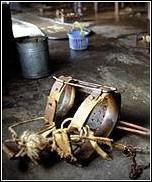Dozens of bears, kept alive only for their bile, were trapped in cages
so small they couldn't move, their bellies spiked with crude, dirty,
often- infected devices to allow the farmers to "milk" their bile twice a
day and sell the fluid secreted by the liver as medicine.
 In the 1980's, China set up bear farms to extract the bile from the gallbladders
of living bears. Despite its original intentions to 'conserve' bears,
farming bears has created problems of its own. Over 7,000 bears,
originally taken from the wild are kept in bear farms in China. This is
cheaper than breeding bears in captivity.
In the 1980's, China set up bear farms to extract the bile from the gallbladders
of living bears. Despite its original intentions to 'conserve' bears,
farming bears has created problems of its own. Over 7,000 bears,
originally taken from the wild are kept in bear farms in China. This is
cheaper than breeding bears in captivity.
Because of the demand for stock bear farms, as few as 12,000 bears may
be left locally in the wild. As it is cheaper, farmed bile has actually
increased the market for bear parts. Farmed bile is smuggled all over the
world, but it is still viewed as inferior to bile from a wild bear because
of the poor conditions in the farms.
Wild bears continue to be poached for their gall in China. At the
farms, bile is surgically extracted from the gall bladder through a steel
tube surgically inserted into the body of the bear. This device often
causes pain and infection. The bears are kept in very small cages in which
they can barely move. As well as destroying their muscles and bones, this
confinement causes deep psychological disturbance to the animals. Most
sway from side to side repetitively. Compared to an average twenty-five
year life expectancy in the wild, farmed bears usually only survive
between four and ten years. Physically debilitated and psychologically
disturbed, these bears can never be released back into the wild but can
thankfully be transferred to a sanctuary such as those operated by Animals
Asia Foundation or WSPA so that they may lead a relatively much healthier
life.
Both farmed and wild captured or poached bears will have their fat,
skin, paws, bones, claws and other parts removed for use in traditional
medicines, meals in expensive restaurants or as
charms.
Barbaric
Torture
Over 7,000 bears are kept in bear farms in
China. In the farms, bile from the gall is extracted through a steel tube
surgically inserted into the body of the bear. This process causes extreme
pain, infection and distress. The bears are kept in very small cages in
which they can barely move. As well as destroying their muscles and bones,
this cruel confinement causes deep psychological disturbance to the
bears.
Compared with the average 25 year life expectancy of a wild bear, these
caged creatures only survive about 4 years and slowly die of
extreme torture
Consumers
The largest consumers of bear products are Korea,
Taiwan, Japan, China and Asian communities through out the world.
Alternatives
Ready alternatives are available in traditional
Chinese medicine from herbs. There is even a synthetic version of bear
gall made from cow gall known as UDCA. This is manufactured in large
quantities and is widely available at a fraction of the cost of bear gall.
There is not one shred of evidence that Bear bile treats anything or
anyone. Yet these brutal Chinese torture the bear without any
anesthesia, 24/7/365
Chinese Torture of Bears
Bears are hunted legally for recreation in China. They are
also poached for their skins as rugs and trophies. Body parts from bears
are used to supply the traditional Chinese medicine trade and exotic meat
market. Their Paws are cut off while they are
still alive to use for "Bear soup."
See more links on this~~~
'Torture chamber' agony of China's bears
The Unbearable Trade in Bear Parts and Bile
AND THIS IS THE ORGANIZATION THAT WORKS TIRELESSLY TO RESCUE
THEM
AF - China Bear Rescue